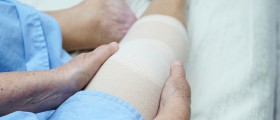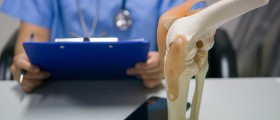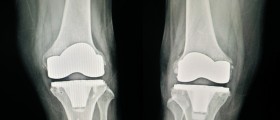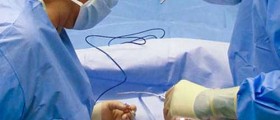There is a variety of problems an individual can experience in connection to the knee. Many older people have arthritis which requires the operation since the drugs are ineffective. Sports injuries are also quite possible. We have to know that the knee joint is the most pressured joint in our body. Since this is an extremely important part of the body, because of the work it does, the possibility of damaging it is quite high. Treatments are very different since there are so many causes of damage to the knee joint.
In the following text, we will focus on the processes of treatment and the recovery time necessary after knee surgery. This period depends on many factors such as the state of the patient's body and the type of knee surgery. It usually takes six to eight weeks for the knee to regain its strength suitable for walking, while some bigger efforts and activities demand up to several months or recuperation.

Arthroscopic Knee Surgery
Arthroscopy is a surgical procedure performed by creating an incision on the knee in order to reach the area necessary for the completion of the procedure. This procedure is usually done in order to diagnose the problem, but it can also be used for the removal of broken bone fragments or damaged meniscus/ menisci.
The recovery can be very quick and some patients even regain full knee ability in just a couple of weeks. However, in general, the recovery usually lasts for about eight weeks. During this period, patients need to elevate the operated leg and use ice packs in order to deal with swelling.
- We included 13 RCTs and 12 observational studies. With respect to pain, the review identified high-certainty evidence that knee arthroscopy results in a very small reduction in pain up to 3?months (mean difference =5.4 on a 100-point scale, 95% CI 2.0 to 8.8) and very small or no pain reduction up to 2?years (mean difference =3.1, 95% CI ?0.2 to 6.4) when compared with conservative management.
- Of 710 unique references screened in title and abstract, 149 articles underwent full text screening, of which 13 RCTs informing the effects of knee arthroscopy and 15 studies informing the complications of knee arthroscopy proved eligible.
- With respect to function, the review identified moderate-certainty evidence that knee arthroscopy results in a very small improvement in the short term (mean difference =4.9 on a 100-point scale, 95% CI 1.5 to 8.4) and very small or no improved function up to 2?years (mean difference =3.2, 95% CI ?0.5 to 6.8).
- Alternative presentations of magnitude of effect, and associated sensitivity analyses, were consistent with the findings of the primary analysis. Low-quality evidence suggested a very low probability of serious complications after knee arthroscopy.
Depending on the type of the knee problem, some alternative procedures may be necessary or can be considered as treatment alternatives.
Arthroplasty is one of these. This procedure is done when there is physical damage to the joint cartilage. In this case the affected cartilage is replaced by a metal or plastic replica of the cartilage.
Recovery Process
A very demanding process follows the surgery. After the operation, the patient will regain ability to walk after a week, and full strength in three months. Once the three months pass, the patient should not have problems with any activity.
Nevertheless, during the recovery, the affected leg needs to spared as much as possible. Physical therapy is a part of the recovery since it allows the operated knee to slowly regain its strength and mobility.
The final surgery is the knee replacement. This operation requires a very long recovery.
Patients have to wait a year in order to do more demanding knee activities. During the recovery from this operation, frequent check-ups are needed and a lot of physical therapy.
The process of recovery for any of the surgeries mentioned can be long and difficult. But it is important not to exert the knee early, since it can only cause additional damage and serious problems. It can even cause the return of the injury. So, try to move as less as possible, ask your friends or family to help, and most importantly, listen to the advice of your doctor.
What Exactly is the Patellar Reflex?
The patella is a bone in the knee, or, to be more precise, it is the knee cap, and it functions as the knee extension, increasing the force of the tendon on the femur. The patellar reflex is actually another term for the knee jerk, which is a typical reaction when, for example, a doctor taps on the patellar tendon, the one located under the knee, with a tendon hammer.
The patellar reflex is a result of stretching of the quadriceps muscles in the thigh. The same stretch reflex can be expected when a muscle or a tendon in that area is hit, and this is Somatic reflex arc. What really happens then is that the muscle contracts and many people may not know that this response is actually the reflex of the spine.
When it comes to the importance of the patellar reflex, it is significant to mention that it plays a major role in maintaining the posture and balance, thus allowing a person to walk without having to think about every single step.
The main purpose of the above mentioned patellar reflex test is to determine the state of the nervous system; whether it is properly functioning or not, and whether there is any damage to the motor nerve or spinal cord. The person examined is in a sitting position with the knees bent, or with one leg crossed in a way that the upper foot hangs of the floor.
Conclusion
To sum up, our knee is a very important part of our body, serving numerous purposes, especially when it comes to enabling us movement. However, some injuries may lead to a necessity of knee surgery. If this is the case, arthroscopic knee surgery is a common scenario. Fortunately, most patients who undergo this surgery recover perfectly fine, during a course of several weeks.

















Your thoughts on this
Loading...